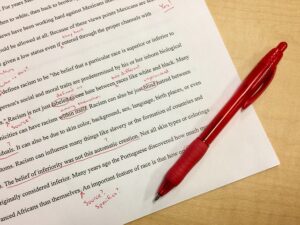Editing :
We are often asked why we insist on having author manuscripts edited. “The other service providers don’t insist,” they say, “so why do you?” Besides, an author who has spent a considerable amount of time writing the book feels that all errors and omissions have been addressed, so why the need for another, paid, round of editing?
There is no denying the fact that the book you have written is the best you could write. But there are professionals in the field who can help you make your book a better one. There are many aspects of a book that must be addressed and a round of editing takes care of all those aspects.
Copy Editing :
 Copy editing makes sure that the author’s raw text is corrected in aspects of spelling and grammar. Copy editing also involves, among other things, ensuring that the text flows properly, that nothing is missing or redundant, that sentences and paragraphs are uncomplicated and of adequate length and that the consistency of characters and plots is maintained. A copy editor also ensures that illustrations support the text and have appropriate captions.
Copy editing makes sure that the author’s raw text is corrected in aspects of spelling and grammar. Copy editing also involves, among other things, ensuring that the text flows properly, that nothing is missing or redundant, that sentences and paragraphs are uncomplicated and of adequate length and that the consistency of characters and plots is maintained. A copy editor also ensures that illustrations support the text and have appropriate captions.
In addition, our editors will eliminate redundant words, replace repetitive words with appropriate synonyms, and will substitute weak words, phrases, and sentences with alternatives that deliver more impact or are more relevant to your subject matter. During all this, our editors will make sure your original tone remains intact. After a round of editing, we insist that the author reads and reviews these changes.
Substantive Editing :
 Substantive editing, sometimes called structural editing, focuses on the content, organization, and presentation of the entire text, viewed wholly, from the title through to the ending. As part of this service, the editor will look at various aspects of the book, aspects such as :
Substantive editing, sometimes called structural editing, focuses on the content, organization, and presentation of the entire text, viewed wholly, from the title through to the ending. As part of this service, the editor will look at various aspects of the book, aspects such as :
- Structure of your plot
- Development of your story
- Stated point of view
- Setting (the ambiance you have created)
- Readability of sentences
- Development of characters
- Tone, voice & dialogue
- Pacing (how fast or slow your book goes)
Proofreading :
 During this process, the proofreader reads the proof (usually an already-edited manuscript) and acts only as a quality check for spelling and grammar, making sure that the copy editor has not missed something. The proofreader is not responsible for the overall consistency and accuracy of the text.
During this process, the proofreader reads the proof (usually an already-edited manuscript) and acts only as a quality check for spelling and grammar, making sure that the copy editor has not missed something. The proofreader is not responsible for the overall consistency and accuracy of the text.
Editorial Review :
 Our editorial review service will combine an editorial evaluation of the manuscript i.e. its plot, structure, dialogue, development of characters, along with grammar and punctuation, with the readability of a work i.e. an assessment of how well the narrative ‘flows’. The evaluation is written by a professional editor after reading and evaluating the particular work. It does not involve editing of the work.
Our editorial review service will combine an editorial evaluation of the manuscript i.e. its plot, structure, dialogue, development of characters, along with grammar and punctuation, with the readability of a work i.e. an assessment of how well the narrative ‘flows’. The evaluation is written by a professional editor after reading and evaluating the particular work. It does not involve editing of the work.
Comprehensive Editing :
Substantive Editing + Editorial Review = Comprehensive Editing
 A well-edited book may not guarantee sales but it surely ensures that there is no loss of sales. Remember the last time you put a book back on the shelf because it had a few errors? Read more about why editing is the most important marketing tool you can employ by clicking here.
A well-edited book may not guarantee sales but it surely ensures that there is no loss of sales. Remember the last time you put a book back on the shelf because it had a few errors? Read more about why editing is the most important marketing tool you can employ by clicking here.
So, while we do not know why the other self-publishing service providers do not insist on a round of editing (we wish they did, if it weren’t important would traditional publishers place such a premium on their editors?), we can only speak for ourselves and ensure that everything that can be done to improve the book has indeed been done.
So, if you choose this service, a professional editor will review the manuscript you provide and suggest corrections to it. You may then choose to accept or reject these suggestions That way, nothing changes without your express permission.
Guidelines for submitting the manuscript :
As part of the normal publishing process, we will help you put together your manuscript for editing. The manuscript should be submitted in an A4-size page format. Further, all chapters of the book should be submitted as one document, not individually. If your book contains images, these may be placed inline within the document or submitted separately with indications of which image goes where, and should be submitted at the same time as the text file.
It is important that your manuscript is finalised and completed in all aspects before it is submitted for copy editing. Later changes to the manuscript may entail further charges.
Frequently Asked Questions :
Can I use POD to sell on Amazon? Can you help?
What you are probably asking is whether we will list your book on Amazon, print a copy when it is sold, and dispatch that copy to the buyer (i.e. whether we will print on demand). Yes, we do that, not just for Amazon but also for Flipkart and The Dogears Bookshop, and other platforms where we list your book.
How does Print-On-Demand offer a better alternative?
Print-on-demand helps authors and small publishers because they can now print books on an as-needed basis instead of printing a large number of books all at once. This also helps small businesses save money, for instance, on printing manuals and reports. Similarly, print-on-demand makes it possible for publishers to offer older books (back lists) without having to print a large number of copies.
For details on how print-on-demand, in particular, and self-publishing, in general, might be of use to you, see which publishing solution may be applicable to you.
Isn’t POD expensive?
POD implies a higher cost per book, but to appreciate POD, a little knowledge of the economics behind it might help.
Imagine you have written a book and have decided to take the self-publishing route i.e. you have decided to publish the book yourself. You get your book edited, lay out your text, design your cover and approach the printers. You see a market for only 100 copies (for argument’s sake) but your printer says you must print a minimum of a thousand copies (they too can’t help it as small quanities are expensive for them too). The cost of each copy is small, say Rs. 40 per book, but having to print a thousand copies means you have to invest a total of Rs. 40,000/- upfront. You are not sure if all the copies will sell but that is a gamble you are forced to take.
Or imagine you choose to work with us at CinnamonTeal Publishing. Your book is made available for sale on a few online bookstores. When a book is sold on these platforms, the book is printed and dispatched to the buyer using the POD option. Because the buyer has already paid for the book, you, the author, do not have to spend on its printing. In this case, the same book that cost Rs. 40 when printed in bulk might cost around Rs. 120/- when just one copy is printed (using POD technology), but because 1000 copies have not been printed, the author has to spend lesser (Rs. 120 instead of Rs. 40,000/-) and not have to worry about shipping and storage costs, or about whether or not the remaining copies will get sold. Similarly, if you wish to have a few copies of your book for yourself, you do the same – order only as many as required. So if you need just 20 copies, assuming the same cost per unit, you pay only Rs. 2400/-.
How does the quality of a book printed on demand compare to that printed via the offset method?
Print-on-demand technology has continually been refined during the past ten years, and book quality has improved tremendously. Print-on-demand books are indistinguishable from other books printed in large quantities using an offset press. CinnamonTeal books feature color covers, clean graphics, and easy-to-read text. While the quality remains the same, print-on-demand methods costs much lesser than an investment in offset printing (when total costs are compared and small quantities are printed).
What if I need more copies printed?
Simply email us and we will have the required number of copies delivered. Please note that all orders will be processed only after they are paid for in full. The amount will be invoiced to you before the order is processed.
In case of third party orders (such as books dispatched to distributors), the books must be paid for in full before they are printed and dispatched.
We also provide bulk printing services.
